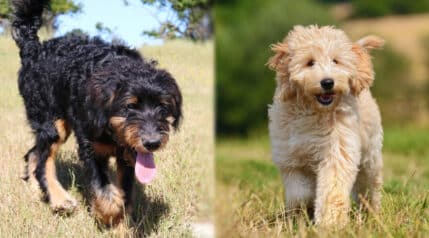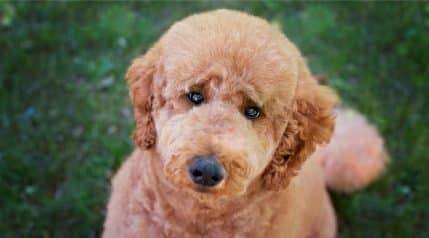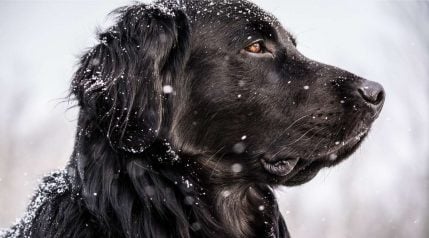There is much debate in the canine kingdom about the Anatolian Shepherd and the Kangal and whether they are the same breed or not. We’ve sifted through all of the conflicting canine information to find the most recent and reliable facts. We look at what the professionals say and the key differences between the breeds, resolving this controversy once and for all.
Suppose you’re here because you’re looking for your next family dog, or you’re venturing into the world of giant pups. In that case, neither of these canines is the best choice. Both are hardworking, protective shepherd dogs who are not suited to the average family. But if you’re searching for a protective shepherd dog for your ranch, they don’t come much better than these two.
So, let’s get down to the doggy details and discover the truth about these valiant Turkish beasts.
If you are not certain of your dog’s genetic makeup, you can use an at-home DNA test kit to find out.
Breed Comparison
Anatolian Shepherd
- Height 27.5 - 32 inches
- Weight 88 – 143 Pounds
- Temperament Independent, loyal, reserved
- Energy Active
- Health Better than Average
- Lifespan 11-13 Years
- Puppy Prices $1,000 and Up
Kangal
- Height 28-32 Inches
- Weight 90-145 Pounds
- Temperament Alert, territorial, affectionate
- Energy Active
- Health Better than average
- Lifespan 12-15 Years
- Puppy Prices $1,500 and Up
Breed History

The breed’s history should be one of the first things that you look at. Not only does it tell you a lot about them and their original purpose. But it can also give you a fantastic insight into what to expect from them in the family home. These breeds have very similar histories that are intertwined with one another. So, let’s take a look.
Many believe that these two breeds both descended from ancestors of modern Molossoid type-dogs dating back to 2,000 B.C. The British Museum houses Assyrian bas-relief carvings, which show large dogs that resemble Turkish Shepherd dogs. For a long time, many people and registries considered these dog breeds to be the same breed.
The American Kennel Club (AKC) considers them the same breed and consolidates them under the Anatolian Shepherd name. The other principal registry in America, the United Kennel Club (UKC), recognizes the Anatolian Shepherd and the Kangal Dog as separate breeds. They recognized Anatolian Shepherds in 1993 and Kangals in 1998. On the contrary, in 2018, the Federation Cynologique Internationale (the combined registry for mainland Europe) deemed that the two breeds are so similar that they should be considered the same. And they are now both recognized as the Kangal Shepherd Dog.
These dog breeds originate from Turkey. They were bred to protect their master’s livestock without little or no human supervision. They are capable of fighting wolves, bears, jackals and sourcing their food. Anatolia was the name given for the central part of Turkey, hence the name Anatolian Shepherds. The name Kangal derives from a specific area in Turkey, the Kangal District of Sivas Province, where the Kangal breed is mainly found. The Kangal is a national treasure, and they are the official breed of Turkey. Kangal dogs are sometimes referred to as Karabash as well.
According to the AKC, a pair of Anatolian Shepherds were imported into America just before World War II to participate in the top-secret “Sheepdog Project.” This mission aimed to discover which breeds were best suited to the needs of American pasturelands and ranchers. American farmers began importing Anatolians from Turkey in the 1950s. Lieutenant Robert Ballard is the individual credited with breeding the foundation of all Anatolian Shepherds today.
The welcoming of Anatolian Shepherds into America coincided with the Endangered Species Act (ESA). This required ranchers to regulate the population of predatory wolves without killing them. It is the nature of all Turkish Shepherd dogs to intimidate predators rather than fight them, making them the ideal option for ranchers across America.
Those that believe that Kangals are a separate breed state that Kangals are still, to this day, a closely guarded secret of Turkey. And the exportation of purebred Kangals is forbidden. Sure, there are a few differences between the two species when comparing their different breed standards. But there is no clear-cut answer as to whether they are officially distinct breeds or not.
Appearance

They are both large to giant-sized dog breeds that require lots of room in the home. With their long legs holding up a bulky, robust frame, it is clear to see how powerful they could be against ferocious predators. But equally, they aren’t formidable in appearance compared to some other dog breeds. Instead, they have a fairly gentle face with a soft yet alert gaze.
According to the UKC breed standards, Kangals are the slightly larger pup of the two, but only by two pounds. Anatolian Shepherds can also be shorter by half an inch. Both of their tails curl, getting tighter as they become increasingly alert to something.
They both have a double coat that shields them from Turkey’s harsh elements and climates– freezing, cold winters, and scorching, dry summers. However, it is their coat length and coloring that enables many to tell the two breeds apart. An Anatolian Shepherd has a short or semi-long coat, and it is much denser around the neck, shoulders, and thighs. All colors are acceptable in the Anatolian breed.
Kangals typically have shorter coats. The outer jacket is slightly harsher to the touch compared to the Anatolian Shepherds. And the cashmere-like undercoat is soft and dense. They also have slightly longer hair around the neck, shoulders, and tail. Another telltale sign that many Kangals have is a flatter strip of hair running along their topline.
For Kangals, there are additional coloring rules because it is such a vital characteristic. In Turkey, any deviation indicates that the dog in question is not a purebred Kangal. A true Kangal always sports a solid color that ranges from a light dun to a dull gold or a steel gray. They should also wear a black mask that covers the muzzle and sometimes extends over their head. Ears should always be black. The tail is usually black-tipped, and often a black spot in the middle of the tail is present.
Temperament

Both of these dogs are natural guarders, and they protect their flock or family to the death if they need to. They are not brutes looking for a fight. Instead, they stand their ground, barking and growling until their opponent backs off. So, if you’re a cowboy looking for an independent canine colleague to protect and herd your flock, both tick all the boxes.
They both become bored with average family life, so they’re not suitable for most dog owners. And they protect their home at night with their booming bark, annoying neighbors several streets over. Anyone living near noise-sensitive neighbors should think twice about these breeds. They are aloof with strangers, and visitors should not attempt to fuss with them.
If you’re looking for a family Fido to play fetch in the park with, these are not the breed for you. They haven’t got much time for playing as they are serious dogs. They are surprisingly affectionate with their master. They occasionally enjoy sitting in front of the fire surrounded by their human pack. However, you’ll mostly find them guarding their perimeter outdoors or sleeping by the window with one eye open. Some say that a Kangal is more affectionate.
Exercise

They are active dog breeds that are always on the go in the form of protecting their home. As such, they don’t need to be walked outside of the house like other dog breeds. Instead, they are self-exercising. They get enough exercise every day while patrolling their homes and yards. If you do not have access to vast private and secure land, neither is a good match.
They have active minds, but guarding their homes is enough to keep them occupied. Historically, they patrolled the mountains alone for months on end, with nothing to do but watch their flock for entertainment. As a result, many families mistakenly assume they can sit idly in their homes, but this is not the case. If they are not satisfied with their lifestyle, they become destructive and unmanageable.
Training

They are not interested in giving a paw or spinning for a treat. Essentially, they do what they want, which is to patrol and protect the family. They are headstrong, dominant personalities that always think they are correct. This makes them unsuitable to inexperienced dog owners or average families because they are a challenge to train.
Instead, they need a very experienced dog owner who can work with them and treat them as they want to be treated – independent, four-legged employees. Their owner needs to be a firm pack leader who can show them the ropes and establish the rules should they get out of hand.
Although they are not what you would consider family pets, they still need to be socialized from a young age. Mix them with as many dogs as possible, and invite plenty of visitors to your home. This way, they learn the difference between a friendly stranger and a potential danger that they need to watch.
If you want them to live peacefully with other family pets, they need to be raised alongside them from a puppy. Their protectiveness can sometimes translate into aggression, and they might see new or outside animals as a threat. Socialization goes a long way in shaping their personality. Both of these breeds can and do live with children, and they’ll see them as younger members of the flock that needs to be protected.
Health

The Kangal often lives a few years longer than the Anatolian Shepherd. Anatolians and Kangals are both sensitive to anesthesia, sometimes making treatments difficult. Because they are rare dogs, you should always remind your vet of this just in case they are not aware.
Although it does not appear frequently, these breeds’ most common health concern is hip and elbow dysplasia. It occurs as a result of abnormal formation of the joint. Responsible breeders screen their breeding dogs for these concerns. Parents should have their hips scored as fair or above by the Orthopedic Foundation for Animals, PennHip, or equivalent bodies.
Could Pet Insurance Help?
If your pet insurance covers exam fees and your dog needs to be examined, there is a good chance your policy will reimburse those costs based on your policy details. However, if you are a new customer, vet expenses will not be covered until after your policy’s defined waiting periods, so signing up once you have an existing health concern is not going to help this time. Pre-existing conditions are not covered by any current pet insurance plans.
This is why it is a great idea to sign up for a pet insurance policy when your pet is young and relatively healthy to ensure you will be covered when you need it most.
Nutrition

They both eat the same on average, usually between three to four cups a day. They both need to eat a kibble explicitly designed for large breed dogs. This is especially true during puppyhood as it can also help reduce the chances of developing skeletal problems such as hip and elbow dysplasia.
Grooming

They’ll both need their coats brushed two to three times a week because they are very thick. Without regular grooming, they’ll become disheveled-looking. Frequent grooming helps to stimulate blood circulation in their skin, promoting a healthier coat.
They shed heavily during the shedding seasons, particularly from their winter to summer coats. You should brush them most days if you don’t want hair hurricanes in your home. And you’ll need a de-shedding tool to tackle their shedding. Neither of these breeds is prone to becoming dirty or bathing in mud, so a bath once every two to three months should suffice.
Puppy Prices

The price of an Anatolian Shepherd puppy is usually a little lower than the much rarer Kangal. This is because the exportation of Kangals from Turkey is reasonably limited. The average starting price of an Anatolian Shepherd puppy is $1,000, compared to $1,500 for a Kangal. The cost of adopting either breed is much lower, but there are few Anatolians and Kangals in rescue homes.
Your wait might be much longer for a Kangal compared to an Anatolian, considering the limited number of Kangal breeders. But it’ll be worth its weight in gold to find a reputable breeder. These protective and potentially aggressive dogs need the best start to life to transform into polite dogs. And irresponsible breeders and puppy mills don’t socialize or care for their puppies as they should.
The Anatolian Shepherd Dog Club of America lists reputable breeders who have signed their code of ethics, as does the Kangal Dog Club of America. So be sure to check these sites out when starting your journey to buying either an Anatolian or Kangal puppy.
Remember that there are additional costs to consider when buying a puppy on top of the initial puppy price. The Kangal might be the more expensive of the two regarding the initial puppy price. Still, after this, they cost relatively the same considering their similar size and lifestyle.
Final Thoughts
There is heated debate about whether Anatolian Shepherds and Kangals are the same dog breed. From the comparison above, it’s easy to see why many people and canine registries believe they are the same breed. They look almost identical, originate from the same location, and share the exact breed purpose. They have very similar personalities too.
The main difference falls in their respective breed standards. Kangals are sometimes taller and can weigh up to two pounds more on average. The Kangal also has a shorter coat, with a solid coat color complemented by a black facial mask. In comparison, any color is acceptable for an Anatolian Shepherd. It is these slight differences that set the two apart.
Whichever breed you choose, know that you need to offer them what they need, which is effectively the same thing. They both require a large home with access to vast private and secure land. If you are highly experienced with dominant dog breeds, you will be more successful with these two pups. But don’t expect them to be the typical canine chum. They offer you, your family, and ranch animals maximum protection and companionship in exchange for your hard work.







there is nothing you westerners won’t try to steal or take away from us is there.
Those came with us from steppes. most likely with Kangar tribe. WE EXIST. YOU WILL NOT ERASE US
Wow. On that note, I guess you only have, aquire or use things specifically from where ever you originated. You don’t enjoy, have or aquire any belongings, vehicles, clothing, furniture, artwork, food, pets from anywhere outside your spot of origination and you havenot and will not relocate. IF YOU HAVE OR DO ANY OF THOSE THINGS you are worse than “you westerners”, as you called them because you are a hypocrite.
Before purchasing my Kangal I contacted several Kennel Clubs for verification. Through my communications I learned that several of the kennel Clubs conducted DNA testing and there were not enough differences in the base DNA to conclude that these 2 breeds were in fact different breeds.
Sure some Anatolians are taller than a Kangal and some Anatolians are lighter and mistaken for a Kangal. Training may be easier on this Kangal over this Anatolian, or vice versa. Some Kangals are scared, some are brave. Some Anatolians have more of a bite force than that Kangal over there.
They are the same breed. Out of 24 kennel Clubs only the UKC recognizes them as different.
My neighbor owns an Anatolian. We both have livestock to protect. When I went to purchase a working dog, I ended up purchasing a Kangal because of it’s coloration. After 9 months I realize his Anatolian and my Kangal could be brothers, especially is mannerisms.
I mean 30″. He’s not Clifford. lol
Still can’t figure out what my rescue dog is. He looks exactly like an Anatolian, except shorter; only about 30′ at the top of his head. I’ve had Anatolian owners assure me he’s Anatolian, by looks. But his reactions to strangers is the opposite of everything I’ve read; he doesn’t meet a stranger. He will get protective if someone make a very sudden move toward me or I give off a very fearful vibe. I’m gonna do his DNA test to be sure.
What is the difference in bite force between the Anatolian Shepherd, & the Kangal Shepherd?
It seems to depend on which variety of each dog and who you ask, but both are around 700 PSI which places them among the strongest bite force in the dog world.
Where do they sell or could I purchase a kangal
“Many believe that these two breeds both descended from Molosser”. Who are those “many” exactly? Akbash and Kangal are attested by scientists, that they were brought from Central Asia by the Turkish nomads, who were, as you know, herders for at least 7000 years. https://www.sciencedirect.com/science/article/pii/S0166218X08003703
https://en.m.wikipedia.org/wiki/Kangal_Shepherd_Dog
Greeks breeding them in Greece and naming them with the fictional dog in mythology, does not make it Greek. Such a huge, steppe breed is not even possible in the rocky and warm terrain of Greece. It is no different than they renamed Turkish coffee in 1950s and started to call it Greek coffee. Please update that speculation with the correct scientific information.
The personality description is bang on. I have a mix breed Kangal or Anatolian. When we first brought her home, I thought we made a mistake getting her. She was aloof and kinda ugly. I tought she was going to be boring, unaffectionate and useless. Was I wrong! Her frst year, we just called her the evil one. She was so bad, we had to replace her and her companion’s collars with chains becakuse she shredded them. We had to keep her on a long chain most of the time because she thught her territory included the neighbour’s property (over a km away) and acss the highway (also 1km away). Now she has a good idea of where her property ends, and respects the boundary most of the time. She is the most affectionate and loyal dog I’ve ever known. And stubborn. When other dogs misbehave, they have the look of regret, when she misbehaves, she has a smug look of satisfaction and defiance. Training her is a challenge but she’s worth it.
Your story’s has so much in common with mine. I adopted my through an agency from NYC – she was brought from KY by mistake and since she was not on the bill of lading they think she sneaked into the van and driver did not noticed that she was an extra… She ended up with me in ME. I run B&B. Upon arrival she gave us a month of hell as we had to chase her around the house and around the neighborhood as she was a master of escape and was able to opening any door or cabinet or fridge. She was very skinny and food hunting was her forte. What she was not able to open she would trash. I had to install a kennel and to buy her stainless steel collar and leash. She tore three sets of leashes in one week. To make thing worse she was using our building as her place to empty her bawls and pee. First month it was a mayhem. I was on round the clock every other hour taking her out or cleaning the mess. Her personality was however most friendly and outdoor she wanted to meet every dog and every stranger. She was very mindful of my little Yorke and cat except for their food. And into the second month things turned around almost as if she was testing my resilience all along. She stopped acting up and run away and started to listen to me and started complying with the boundaries. And her gentle side and her tough side are prominent. She definitely not an average dog to handle but her personality is so prominent and demands respect and her adventurous spirit is contagious. She is with me her first year now and she is remarkably doing great! The trainer who helped me was amazed at her fast progress and how quickly she was able to learn and turn things around. She is 3 yo and her smartness is on a different level. She has wits, strongest survival instincts and she is a hunter. But she is a family dog too who is affectionate and loves being brushed and petted, she answers to every touch with her freezing in pleasure and eyes closing . She is not a kisser or one who would come for affection, but she cannot resist love. She is simply an amazing dog and I feel lucky that she was offered to me to adopt. NYC definitely would not be her ideal place to thrive.
My Anatolian Thor. Is the best most amazing dog I have ever owned. And I have had dogs my whole life. I rescued him. Was told he was a three year old mastiff mix. When I took him to my vet, I was told he was an Anatolian shepherd and was 3 months old. He is now almost 14 yrs old. I don’t what I am going to do when I lose him. I no longer have land. So I’m afraid I’m not going to be able to get another one.
I rescued an Mixed breed Anatolian shepherd of the street. In the blazing sun he was running in circles on the asphalt. He has the personality of the Anatolian and is quite bright. He is my companion, watch dog, protector and my helper. I have taken him from being wild to the most lovely friend ever. He helps me up stairs, off the floor when I say help, out of bed if I need it. All that comes around are at first intimidated until they get to know him and then fall in love with him. Fortunately I have a couple of acres for him to guard. He alerts me when someone pulls up in the driveway, when the neighbors black Shepard is out and about. He doesn’t like him very much. He thinks everyone is coming to visit him (even if they are not). He knows who will give him treats at the bank, Lowe’s. He knows everyone by name. Like I said he is quite bright. I am 68 yrs old. He is my gift from God.
AWWWWWWWWWWE…..so touched by your story. I’m also enjoying the stories from the other people who left a post. Thank you for sharing.
There is a big confusion with all these flock guarding breeds from Turkey beside with the Kangal and Anatolian Shepherd there is also the Turkish Boz Shepherd & the Aksaray Malaklisi. Many people on YouTube got angry at me for this but 1 person says one thing to me and another says something else to me about these breeds. I am still learning about all these dog breeds from Turkey.
Hi to whom this may concern can you show me the difference between the American Bandogg and the Dogo Argentino? thank you very much.